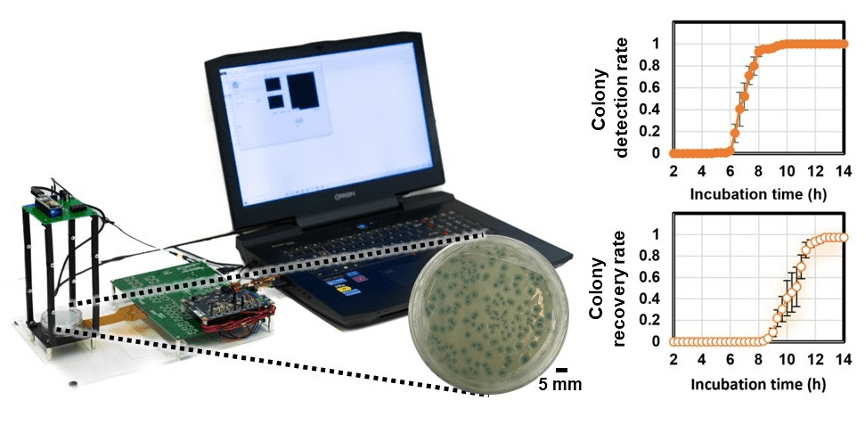A research team led by Professor Aydogan Ozcan from the Electrical and Computer Engineering Department at the University of California, Los Angeles (UCLA) and colleagues have developed an artificial intelligence (AI) powered innovative bacterial colony detection system using a thin-film transistor (TFT) array, which is a widely used technology in mobile phones and other displays.

Image Source: https://cnsi.ucla.edu/project/july-5-2022-deep-learning-accelerates-the-detection-of-live-bacteria-using-thin-film-transistor-tft-arrays-a-technology-widely-used-in-mobile-phone-displays%EF%BF%BC/
Detecting and identifying pathogenic bacteria early in food and water samples are essential to public health. More than 4 billion dollars are spent on pathogenic bacteria infections annually in the United States alone, and they result in millions of deaths globally.
Escherichia coli (E. coli) and other coliform bacteria are among the most prevalent pathogenic bacteria, and they are a sign of fecal contamination in food and water samples. The most common and traditional method for finding these pathogenic bacteria includes culturing the samples, which often requires a final read-out of more than 24 hours and expert visual inspection.
Although some techniques based on, for instance, the amplification of nucleic acids, can cut the detection time to a few hours, they are insensitive to low bacterial concentrations and are unable to distinguish between live and dead bacteria. In order to screen water samples for bacteria, the US Environmental Protection Agency (EPA) does not authorize any nucleic acid-based bacteria sensing methods.
The system was recently published in ACS Photonics, the American Chemical Society (ACS) journal.
AI-Powered Bacterial Colony Detection System is Fast and Accurate
The AI system was able to quickly capture the growth patterns of bacterial colonies without the need for scanning, which was possible due to the ultra-large imaging area of the TFT array (27 mm 26 mm) created by researchers at Japan Display Inc. This resulted in a significant reduction in both the hardware and software design requirements.
Comparing this technology to EPA-approved, gold-standard culture-based procedures resulted in 12-hour time savings. The AI-based system could quickly and automatically detect colony growth with a deep neural network by examining the microscopic images acquired by the TFT array as a function of time. The species of bacteria are categorized using a second neural network after each colony has been found.
By performing early detection and categorization of three different bacterial kinds, namely E. coli, Citrobacter, and Klebsiella pneumoniae, the effectiveness of this automated bacterial colony detection system was demonstrated. In comparison to the EPA-approved culture methods, the researchers were able to discover colonies at a rate of >90% in less than 9 hours and further identify their species in around 12 hours. Additionally, the complete digital processing steps take <25 sec using a standard computer without requiring an advanced graphics processing unit (GPU).
Conclusion
These findings show the viability of an automated, AI-based bacterial colony identification system based on TFT arrays as a quick, affordable, and precise method, particularly suited for resource-constrained contexts.
This automated colony detection technology has enormous potential to be employed in microbiology research and field-based bacteria sensing because of the low cost, low heat generation, huge scalability, and low power consumption of TFT arrays, which are extensively used in mobile displays.
Li, Y., Liu, T., Koydemir, H. C., Wang, H., O’Riordan, K., Bai, B., … & Ozcan, A. (2022). Deep Learning-Enabled Detection and Classification of Bacterial Colonies Using a Thin-Film Transistor (TFT) Image Sensor. ACS Photonics. DOI: https://doi.org/10.1021/acsphotonics.2c00572 https://cnsi.ucla.edu/project/july-5-2022-deep-learning-accelerates-the-detection-of-live-bacteria-using-thin-film-transistor-tft-arrays-a-technology-widely-used-in-mobile-phone-displays%EF%BF%BC/
Learn More About Bioinformatics:
Top Bioinformatics Books ↗
Learn more to get deeper insights into the field of bioinformatics.
Top Free Online Bioinformatics Courses ↗
Freely available courses to learn each and every aspect of bioinformatics.
Latest Bioinformatics Breakthroughs ↗
Stay updated with the latest discoveries in the field of bioinformatics.
Dr. Tamanna Anwar is a Scientist and Co-founder of the Centre of Bioinformatics Research and Technology (CBIRT). She is a passionate bioinformatics scientist and a visionary entrepreneur. Dr. Tamanna has worked as a Young Scientist at Jawaharlal Nehru University, New Delhi. She has also worked as a Postdoctoral Fellow at the University of Saskatchewan, Canada. She has several scientific research publications in high-impact research journals. Her latest endeavor is the development of a platform that acts as a one-stop solution for all bioinformatics related information as well as developing a bioinformatics news portal to report cutting-edge bioinformatics breakthroughs.











